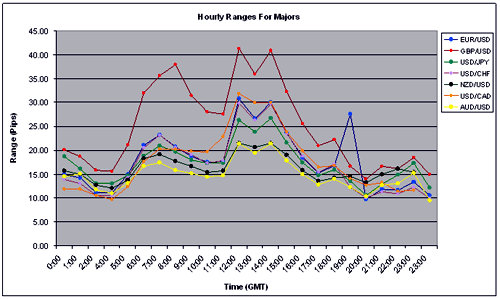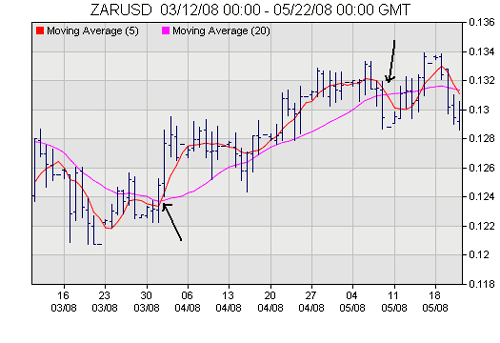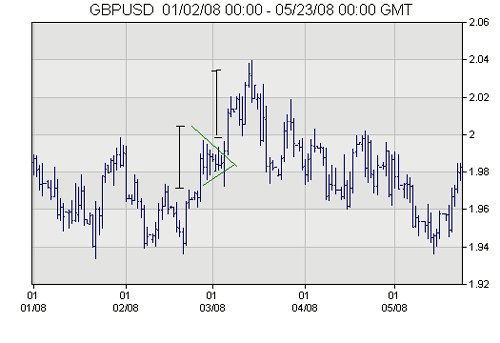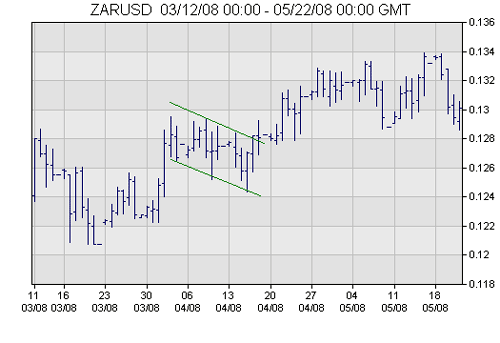Uncover Forex Profits With The Turn Trade
Most traders have an extremely hard time trading with the trend. This observation may seem counterintuitive, as the majority of traders claim that trend trading is their preferred approach to the market. However, after analyzing the records of thousands of retail traders, we are convinced the opposite is true. While everyone pays lip service to the idiom of "The trend is your friend", in reality, most traders love to pick tops and bottoms and constantly fade rather than trade with the trend. In this article, we'll cover the turn trade, a setup which allows traders to have their cake and eat it too: buying low and selling high while still trading with the trend. (For related reading, see Inside Day Bollinger Band Turn Trade.)
| |
The turn trade recognizes the desire of most traders to find turns in the price action (that is to buy low and sell high), but it does so in the overarching framework of trading with the trend. The setup uses multiple time frames, moving averages and Bollinger band "bands" as its tools of entry. (For background reading, see The Basics Of Bollinger Bands.)
Getting Started
We begin by looking at the daily charts to ascertain whether a pair is in a trend, and used a 20-period daily simple moving average to determine the trend. In technical analysis, there are a number tools that can help us diagnose trend, but none is as simple and effective as the 20-period SMA. It includes a full month's worth of data (20 business days) and, as such, it provides us with a very good idea of an average price. Therefore, if price action is above the "average" price, we assume the pair is in an uptrend and vice versa.
Next, we move to the hourly charts to pinpoint our entries. In the turn to trend setup we will only trade in the direction of the trend by buying highly oversold prices in an uptrend and selling highly overbought prices in a downtrend. How will we determine our overbought and oversold extremes? The answer is by using Bollinger band "bands" to help us gauge the price action. Bollinger bands measure price extremes by calculating the standard deviation of price from its 20-period moving average. In the case of hourly charts, we will use Bollinger bands with three standard deviations (3SD) and Bollinger bands with two standard deviations (2SD) to create a set of Bollinger band channels. When price trades in a trend channel, most of the price action will be contained within the Bollinger band "bands" of 2SD and 1SD.
Why do we use the 3SD and 2SD settings in this particular setup? Because the Bollinger band rule applies to price action on the daily scale. In order to properly trade the hourly charts, which are more short term and therefore more volatile, we need to accommodate to those extremes in order to generate the most accurate signals possible. In fact, a good rule of thumb to remember is that traders should increase their Bollinger band values with every decrease in time frame. So, for example, with five-minute charts, traders may want to use Bollinger bands with setting of 3.5SD or even 4SD to focus on only the most oversold or overbought conditions.
Moving back to our setup, after having established the direction of the trend, we now observe the price action on the hourly charts. If price is in an uptrend on the dailies, we watch the hourlies for a turn back to the trend. If price continues to trade between the 3SD and the 2SD lower Bollinger band "bands", we stay away, as it indicates a strong downward momentum.
The beauty of this setup is that it prevents us from guessing the turn prematurely by forcing us to wait until the price action confirms a swing bottom or a swing top. In our example, if the price trades above the 2SD lower Bollinger band on the closing basis, we enter at market using the prior swing low minus five points as the stop. We set our target for the first unit at half the amount of risk; if it is hit, we move the stop to breakeven for the rest of the position. We then look for the second unit to trade up to the upper Bollinger band and exit the position only if the pair closes out of the 3SD-2SD Bollinger band channel, suggesting that the uptrend move is over.
Rules for the Long Trade
- On the daily setup, place a 20-period SMA and make sure that the price is above the moving average on a closing basis.
- Take only long trades in the direction of the trend.
- Move to the hourly charts and place two sets of Bollinger bands on the chart. The first pair of Bollinger bands should be set to 3SD and the second pair should be set to 2SD.
- Once the price breaks through and closes above the lower 3SD-2SD Bollinger band channel on an hourly basis, buy at market.
- Set stop at swing low minus five points and calculate your risk (Risk = Entry Price - Stop Price). (Traders who want to give the setup a little more room can use swing low minus 10 points as their stop.)
- Set a profit target for the first unit at 50% of risk (i.e., if you are risking 40 points on the trade then place a take-profit limit order 20 points above entry.)
- Move the stop to breakeven when the first profit target is hit.
- Exit the second unit when the price closes below the upper 3SD-2SD Bollinger band channel or at breakeven, whichever comes first.
- On the daily setup, place a 20-period SMA and make sure that the price is below the moving average on the closing basis.
- Take only short trades in the direction of the trend.
- Move to the hourly charts and place two sets of Bollinger bands on the chart. The first pair of Bollinger bands should be set to 3SD and the second pair should be set to 2SD.
- Once price breaks through and closes above the upper 3SD-2SD Bollinger band channel on an hourly basis, sell at market.
- Set a stop at swing low plus five points and calculate your risk (Risk = Entry Price - Stop Price). (traders who want to give the setup a little more room can use swing high plus 10 points as their stop.)
- Set profit target for the first unit at 50% of risk (i.e., if you are risking 40 points on the trade, then place a take-profit limit order 20 points above entry).
- Move stop to breakeven when the first profit target is hit.
- Exit the second unit when price closes above the lower 3SD-2SD Bollinger band channel or at breakeven, whichever comes first.
Now let's look at some examples:
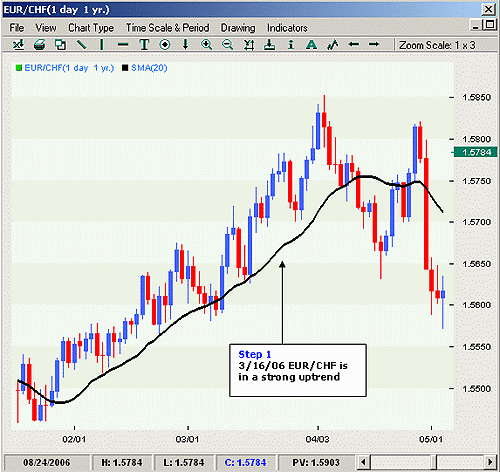 |
| Figure 1: Turn to the Trend, EUR/CHF |
| Source: FXtrek Intellichart |
Taking a look at the EUR/CHF daily chart in Figure 1, we see that since the middle of March 2006, EUR/CHF has traded above its 20-day SMA, indicating that it is in a clear uptrend.
 |
| Figure 2: Turn to the Trend, EUR/CHF |
| Source: FXtrek Intellichart |
Turning to the hourlies, we wait until the pair breaks out of the lower Bollinger band 3SD-2SD zone to go long at market at 6pm EST on March 15, 2006, at 1.5635 with a stop at 1.5623, risking only 12 points. (Note that EUR/CHF tends to be a very low volatility currency pair providing us with very small risk setups. Because the risk is so small, we may choose to set our target at 100% of risk rather than the usual 50% of risk.)
Regardless of our choice, we are able to take profits at 3am EST on March 16, 2006, at 1.5651, banking 16 points on the first unit. We then move our stop to breakeven on the rest of the position and target the upper Bollinger band. We wait for the price to pierce the upper Bollinger band, trade within it; only when it falls out of the upper Bollinger 3SD-2SD band channel do we exit the rest of the position at 1pm EST on March 16, 2006, at 1.5692, earning 57 points on the second lot. Not bad for a trade on which we risked only 12 points.
 |
| Figure 3: Turn to the Trend, USD/CAD |
| Source: FXtrek Intellichart |
The example of USD/CAD shown in Figure 3 and Figure 4 shows a classic turn to trend setup after it establishes an uptrend on March 7, 2006.
 |
| Figure 4: Turn to the Trend, USD/CAD |
| Source: FXtrek Intellichart |
We move from the dailies to the hourly charts and wait until the prices recover above the lower Bollinger band, entering a long at market at 11am EST on March 16, 2006, at 1.1524. We place our stop at 1.1505, which is the swing low minus five pips for a miniscule 19-point risk.
At 10pm EST on March 16, 2006, as price makes a burst upward, we sell half the position at 1.1540 and move our stop to breakeven, locking in 16 points of profit. After the price makes another burst higher, we exit at the first hint of weakness, when the hourly candle closes below the 3SD-2SD Bollinger band zone. This occurs at 11am on March 17, 2006, and we close out the rest of our position at 1.1587, for a 63-point profit on the second half of the trade.
 |
| Figure 5: Turn to the Trend, GBP/USD |
| Source: FXtrek Intellichart |
The example in Figure 5 shows a short trade. On February 15, 2006, we look at the daily chart and see that the GBP/USD is trading below its 20-day SMA, which indicates that it is in a clear downtrend.
In Figure 6, we turn our attention to the hourly chart and try to enter a high probability short when the price becomes overbought on a shorter-term time frame. We do this by waiting for the GBP/USD to close below the 3SD-2SD upper Bollinger band channel, at which time we sell at market (1.7440) and place our stop at approximately 1.7500, risking 60 points. As per our rules, we cover half the position at 1pm EST when price approaches the 1.7410 level, which is 30 points, or 50% of our risk.
Next, we move our stop at breakeven and hold the position, targeting the lower 3SD Bollinger band. Notice that the downtrend re-establishes itself with a vengeance and the price declines into our zone. We stay in the trade until the price breaks back out of the lower Bollinger band channel, indicating that downward momentum is waning. At 6am on February 16, 2006, we cover the rest of the trade at 1.7338, for a profit of 102 points.
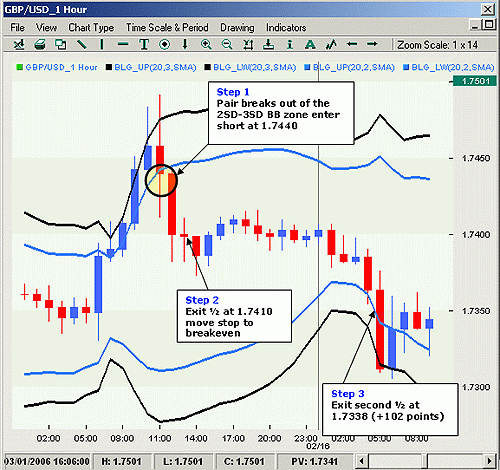 |
| Figure 6: Turn to the Trend, GBP/USD |
| Source: FXtrek Intellichart |
Figure 7 shows another good example of why we always scale out of our positions. On March 15, 2006 USD/CHF is in a downtrend, but the pair begins to trade back up to the 20-period SMA on the dailies. Because we can never be certain beforehand whether this is a retrace or a real turn in the trend, we adhere to the rules of the setup to control our risk.
 |
| Figure 7: Turn to the Trend, USD/CHF |
| Source: FXtrek Intellichart |
Looking on the hourly charts in Figure 8, we see that at 1pm EST on March 21, 2006, the price closes below the upper Bollinger band 3SD-2SD level, and we enter a short at market at 1.3021. Our stop is placed five points above the swing high at 1.3042, for total risk of 21 points.
At 6pm EST on March 21, 2006, the price reaches our first target of 1.3008, and we cover one lot for 12 points of profit or approximately 50% of risk. We simultaneously move our stop to breakeven. At this point, the trade begins to move against us, but our breakeven stop insures that we do not lose any money and, in fact, still bank 12 points of profit on the first half of the position.
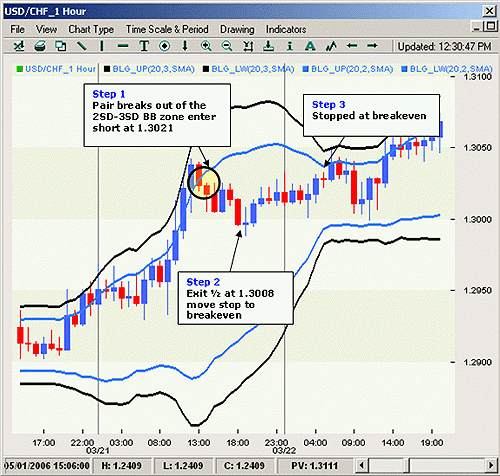 |
| Figure 8: Turn to the Trend, USD/CHF |
| Source: FXtrek Intellichart |
When The Setup Fails
Finally, let's take a look at an example of a failed setup in Figure 9. Starting on March 3, 2006, the EUR/GBP breaks above the 20-period SMA and establishes an uptrend on the daily charts.
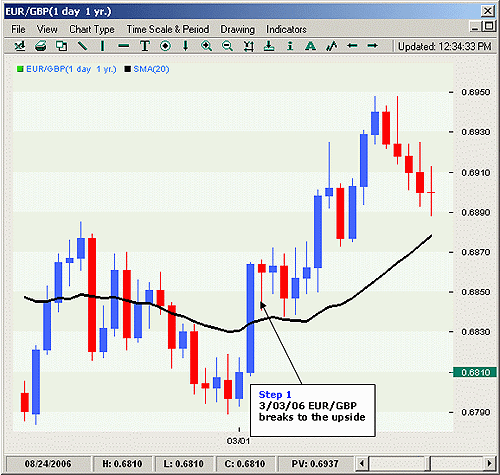 |
| Figure 9: Turn to the Trend, EUR/GBP |
| Source: FXtrek Intellichart |
Using our turn to trend approach, we wait for the pair to make a swing low in the 3SD-2SD Bollinger band zone and then enter long at .6881 at 10am EST on March 14, 2006. The swing low was created at 7am EST that same day at .6878, so we place our stop at .6873, five points below the swing low, risking a total of eight points. Note that the EUR/GBP pair is a very slow-moving cross with very high pip values. A point in the EUR/GBP is worth approximately 175% of a point in EUR/USD, so an eight-point risk in EUR/GBP would translate into a 14-point risk in EUR/USD.
 |
| Figure 10: Turn to the Trend, EUR/GBP |
| Source: FXtrek Intellichart |
Initially, the price makes a small rally but then drops to .6873 at noon EST on March 14, 2006, taking out our stop. This turns out to be the exact low of the move, and many traders may find it incredibly frustrating to be taken out of a trade just before it has a chance to turn around and generate profits. Not us, however. We realize that getting stopped on a bottom tick is just a part of trading and will probably happen more times than we care to remember. Far more important is to appreciate the risk management aspect of the trade, which leaves us only with a slight loss of eight points, thus preserving our capital and allowing us to look for other high probability setups.
To truly appreciate the importance of this dynamic, just imagine the following scenario. Instead of a stop loss, we leave the trade open and instead of turning around, it proceeds to drop even further. Before long, we may be looking at a floating loss in hundreds of points - something that would be inordinately more difficult to make up than our initial small eight-point stop.
Conclusion
Most traders love to pick tops and bottoms, rather than trade with the trend. The turn trade allows you to do both by using multiple time frames, moving averages and Bollinger band "bands" as its tools of entry.
Read more...

